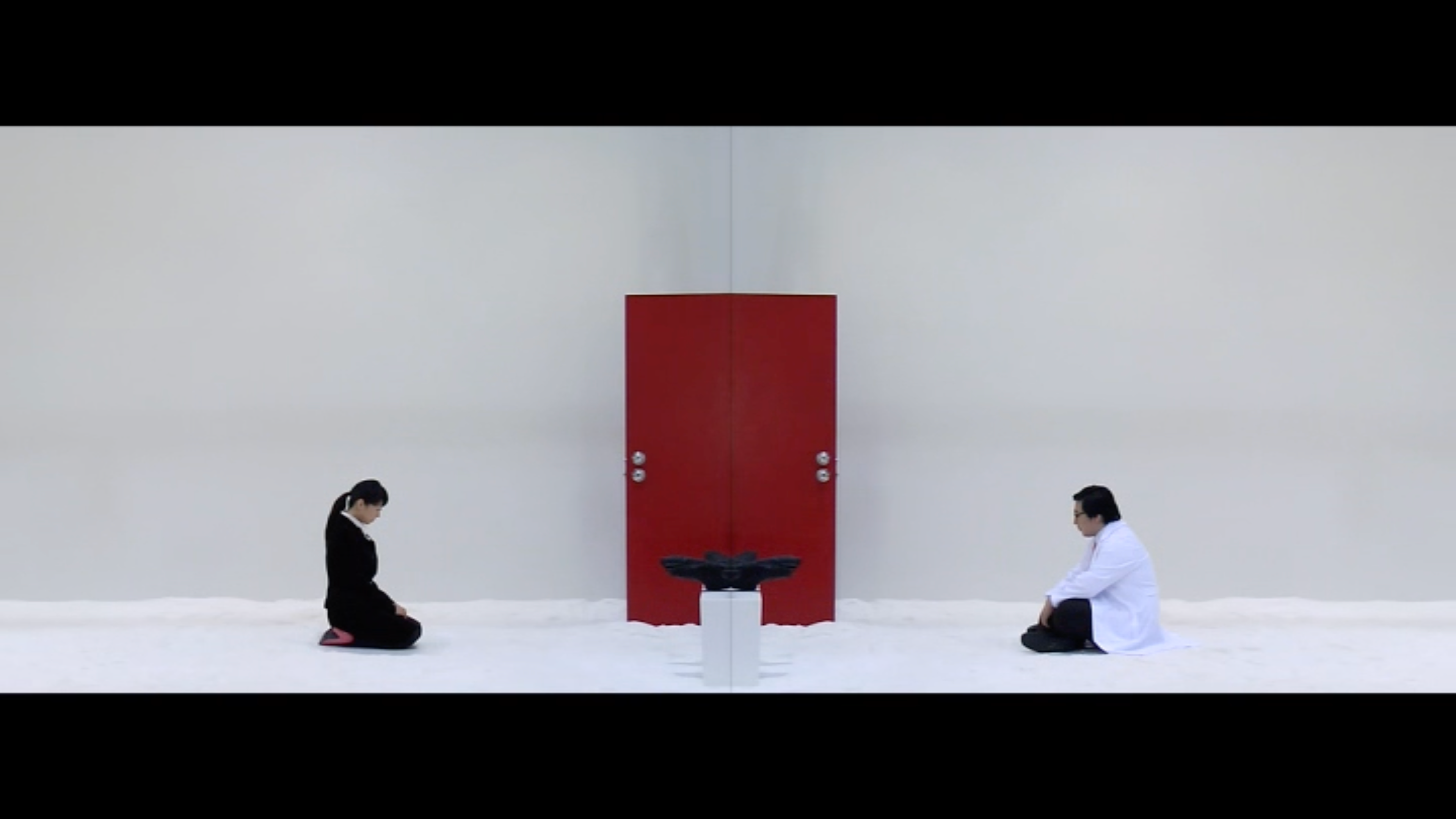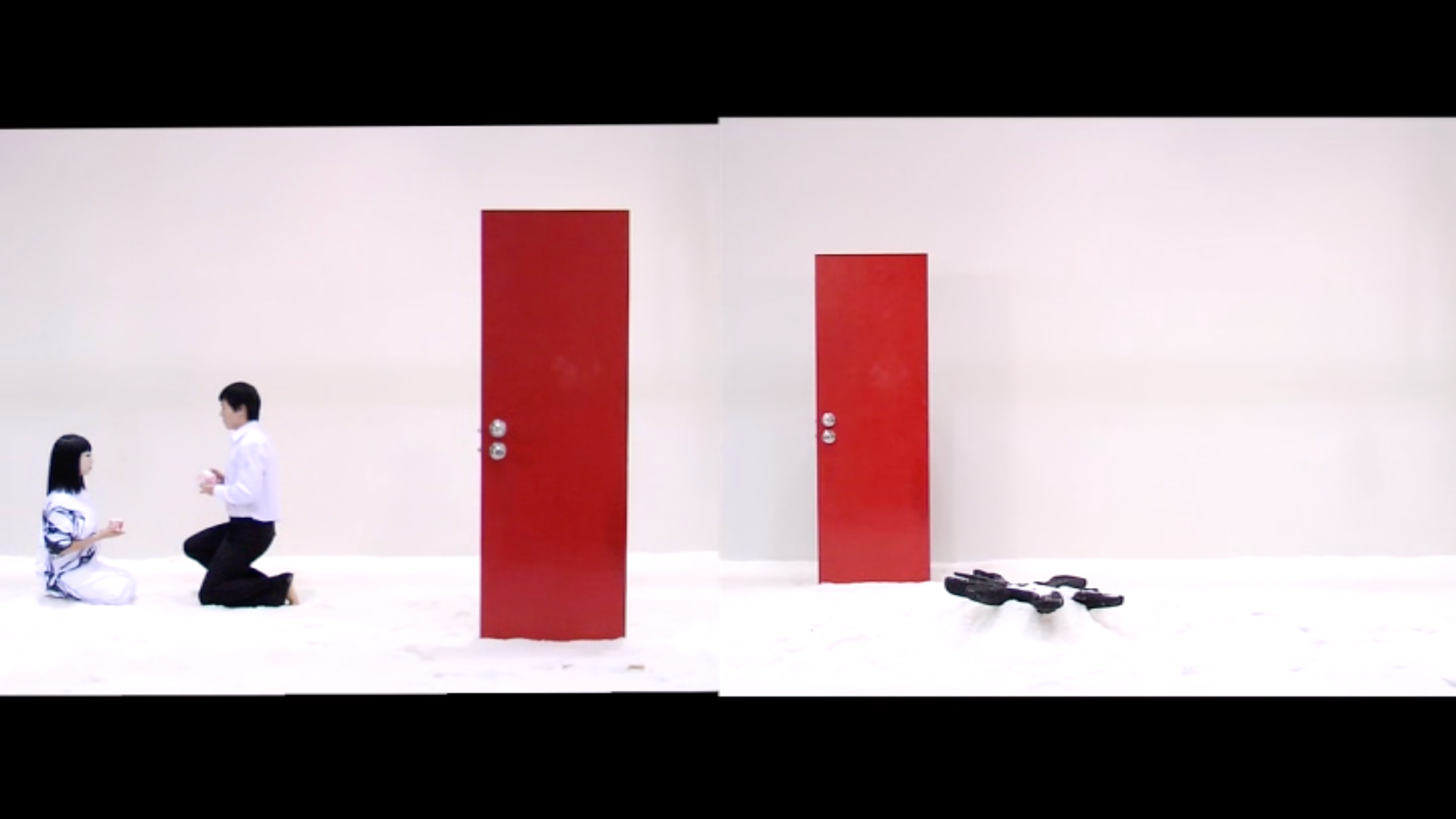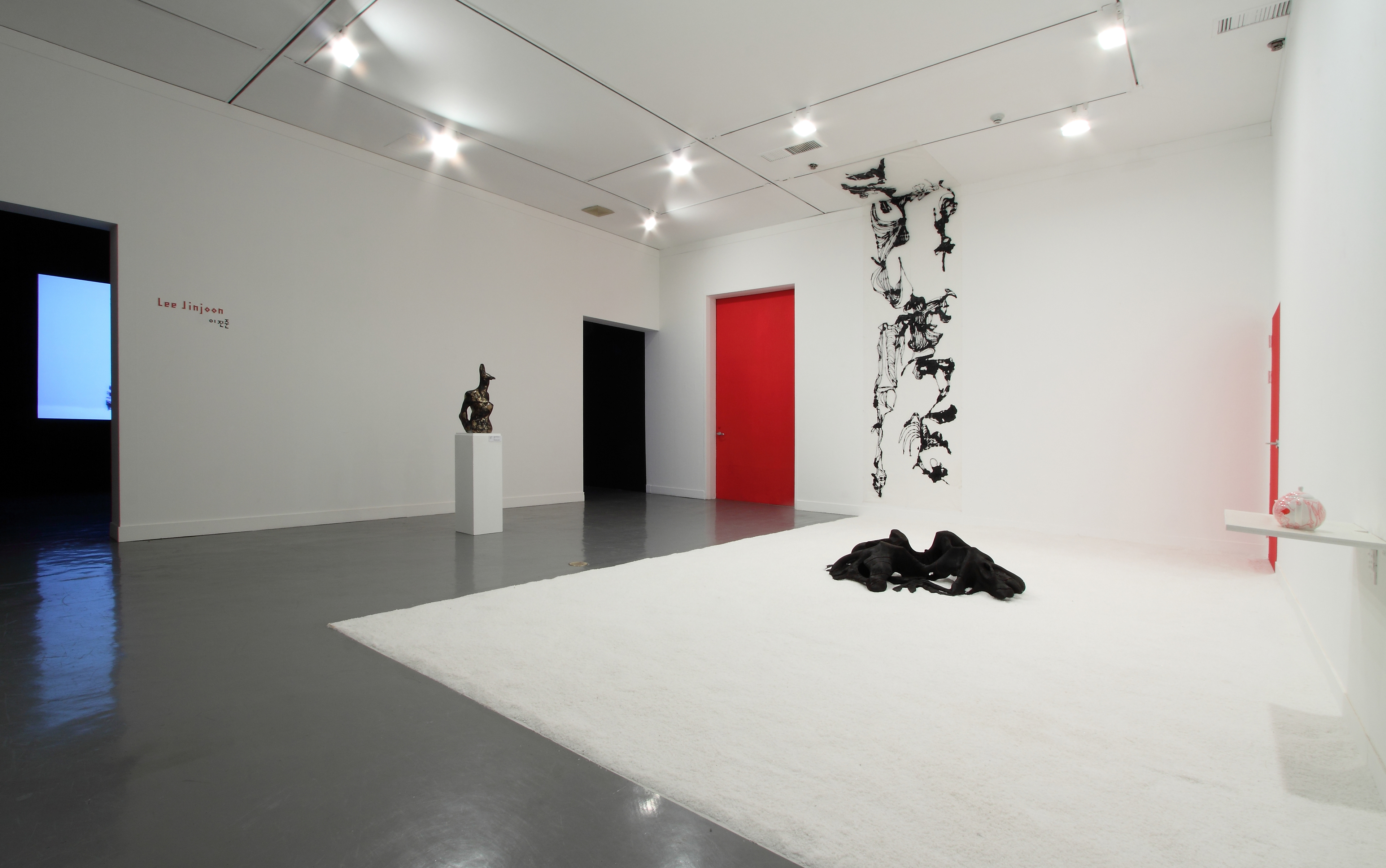by Yong-sung Baek (Art Philosophy, Critic)
Fate and Anxiety
“A religion without practice is no longer a religion." This applies equally to their lives and their destinies. It also holds true for art. Art without practice is already an institution, a self-repeating cycle captured within a hierarchical system of 'aesthetic division' like that expressed by Rancière. However, the practitioner bears a precarious fate, in a dual sense. On one side of the tightrope, there resides the comfortable temptation of conformity to such institutions, while on the other side, there lies a descent into a deep chaos, no longer art but a raging fever. Perhaps the fate of the avant-garde, the practitioner in art, is just as harsh. Yet, having tasted the joy of dance on that tightrope, they refuse to lean towards either side. No. How many practitioners have descended from or fallen off that tightrope?
The artwork Red Door is an attempt at this tightrope act. It is also an avant-garde endeavor concerning the 'encounter' between a woman who is alive but dying and a man who is alive but already a ghost. Here, avant-garde refers to a spirit that explores limits or boundaries while engaging with endlessly unfamiliar diversities. This work is not a common story about dying individuals, nor is it a narrative solely about death. Those seeking some familiar, emotionally moving narrative or familiar 'beauty' in this work will be disheartened. Instead, it can be said that there is something discomforting that surpasses sadness within it.
The woman is a patient with an incurable disease, and the man is a plant-human. Perhaps the man doesn't have to be a plant-human, and the woman doesn't have to have an incurable disease. They don't even have to be a married couple. They could simply be anonymous pronouns called "people." Aren't we already living existence of both being alive and dying? Maybe we are living as ghosts. We constantly encounter each other (family, friends, colleagues, neighbors, authorities, institutions) and greet each other, talk, and ask about well-being. But truly facing each other is not easy.

Red Door: A Study on How We Should Face and Look at Each Other in the Last Moments of Life 2008. 2 Channel video and sound, 10'46".
Therefore, the dual-channel approach from the beginning forms the mode of discomfort. The left represents the woman's space, and the right represents the man's space. Each space is literally "each." They are monads. It is not easy for them to face each other. It is not easy for the audience to face that artwork. Moreover, facing a decisive moment (death) is not easy, and it is not an easy task for the audience to confront and contemplate it. Death has long been removed from modern society. Death has been reduced to a function that should be socially handled, and existentially, it is merely a fear that exists alone on the other side. However, death is not just an unknown other. The dying other in front of me, the dying other I am looking at is present now and here.
Therefore, it is not about turning away from that abyss while dying, but rather how we can face each other is what matters. We cannot desire the heroic death of ancient tragedies here, nor can we desire the heroic death of modern tragedies. Instead, there is a baroque and melancholic allegory. "With decline and only decline, historical events are condensed and enter the theater. This overarching concept of 'falling objects' represents an extreme opposition to the idealized concept of nature that the early Renaissance grasped... People once tried to define the essence of artistic formation through this illusion, but literature, which skillfully unfolds the technique of illusion, fundamentally expelled this illusion from the artwork before the Baroque era." (Walter Benjamin, Origin of the German Trauspiel) In this way, "Red Doors" seems to reject any idealization by using the era of decline as a distant background. There lies a certain discomfort, as Freud called it "the uncanny (Das Unheimliche)," embedded within it.
The Encounter of Monads
Therefore, the problem lies in how we can face the abyss of the monads on the left and right. In other words, it is fundamentally about how we can experience true "encounters" amidst the countless "encounters" of monads. The author raises this question: facing death. It is facing life. It is exploring the possibility of encountering one another. Originally, the word "religion" (re-ligion) in the Western context means to reconnect. Perhaps this reconnection is the essence of true encounter, and thus, the world of "being together." However, no religion or institution in society is truly close to such encounters. Instead, it can be seen that they tear apart and strip away this original encounter, connecting it into the form of organized communities. In the name of the nation, in the name of chosen people. In the name of the organization. Within such a structure, human life becomes a "destiny." A destiny of committing sins without guilt. A destiny of being judged without guilt. Joseph K in Kafka's work is an example. There are structures of those who judge and pass judgment everywhere. Within them, humans suffer under the name of "destiny," and they draw the trajectory of life with the quote, "Even if he dies, shame will survive." The outcry that erupts in Red Door is therefore an outcry that goes beyond the "destiny of destiny." Fragmented memory images pass by here and there. Utility poles, dilapidated streets, a low-hanging sky. Urgent footsteps running somewhere. Images of fateful lives have this allegorical tinge of melancholy. No, it is an allegorical melancholy that only appears to the author who gazes into a predetermined life of destiny. The fluorescent light flickers dimly from the beginning, as if every human life has been determined by that faint glimmer, sensing imminent death. However, this attempt to transcend destiny is also a primal stage that will be cruelly experimented with in the study of death.

Red Door: A Study on How We Should Face and Look at Each Other in the Last Moments of Life 2008. 2 Channel video and sound, 10'46".
Encounter with Tea
Once again, we must return to our respective monads. The woman is preparing for the consciousness of death. It is her own death and yet a ritual of separation from the man. Another ceremony reminiscent of Bill Viola's enigmatic work, "Observance." The man twists, resists, and wanders within the indistinguishable snowflakes falling white. Monads have no windows. The red doors do not open. Communication between them is not easy. It is not easy for lovers or couples to be so nakedly and conclusively divided. The "door" never opens. Monads have no windows. The man approaches the woman without going through the "door." And their final ceremony takes place. The time has come to depart. Tea signifies the "encounter" or "meeting" between them. In Japanese tea ceremony, it is said to be a unique opportunity for human encounters that does not happen in the same way for everyone. So, a cup of tea in the artwork represents both an ending and a unique moment that can happen in a similar way to anyone. Monads have no windows. It is the sacred proposition of each other's dying present, not each other's death, that binds them. To borrow Blanchot's words, "It is not my relationship with my finite self, my relationship of consciousness that I am heading toward death and existing for death. It is my current presence before the other that definitively distances me as I die. It is binding myself to the one who decisively moves away as I die, taking on the sole death that relates to the other's death. Accordingly, I place myself outside of myself. Amidst the impossibility of community, there lies the only separation that makes me open to some community." (The Unavowable Community) Yes, monads have no windows. However, monads are closed yet open.
Binding oneself to the man who is "decisively moving away" is a trembling, fearful, and sorrowful act. However, the decisive and fateful moment is also a moment of true encounter. The teacup starts to tremble, and as it trembles, the woman's hand begins to shake. As the woman's hand trembles, everything focuses on the left channel, and the screen of the left channel begins to tremble white. It is a moment when discomfort is resolved, and everything condenses, being drawn into the trembling within oneself. There is a strange resonance. As the entire screen starts to tremble, a fatal sadness overwhelms. The white light that was in the background now appears in the foreground. A flash. With the eruption of the outcry, the trembling face of the woman, which is the trembling itself, abruptly moves away in a close-up. It collapses. The solemn and low-toned tragic music is absent, and only sounds like rain accompany mourning. Hasty harmony, a cruel restraint regarding beautiful illusions. However, monads coexist and resonate.
The Red Thing
What is that vivid and chillingly red thing? What is a door that does not open? Is it the never-arriving 'sublime,' or does it symbolize the disconnection of the modern world? If so, it would be too cliché. The door that does not open undoubtedly represents disconnection and alienation, but it is also a certain redness. Video colorism firmly bestows the presence of color itself upon us, approaching us with a sense of sacredness. Therefore, we should follow the emotions conveyed by color and coloring, rather than reading symbols. A certain redness. It is a door that seduces us with the most powerful light and color. There is something that might be called desire. It is as if without it, all life would sink into the abyss of dim fate.
The red thing stands on its own. It is as if it calls out the name of the one who is dying, while watching over everything. However, it remains silent. It is not merely a simple play of meanings. It is not a form of communication aimed at conveying a message. Instead, it emphatically declares, "I am silent." If that is silence, has silence ever been endowed with such a strong sensation?
Therefore, the red light contrasts with white words. The contrast with the phrase "I thought there was plenty of time." Words speak, while light remains silent. But what is spoken—the world of white light—is also surrounded by absence. It is the realization that there is a lack despite thinking there was plenty of time. What is that lack, that absence, a time for? It is not the life that has passed. It is something yet to be achieved. It is the something that life has been silent about but must rise. It is the powerful presence of time that strongly persists within the feeling of having lost it, yet not yet recovered it. Therefore, there is a resonance between a certain kind of words and the redness. The redness, as a red something, gazes upon the pains of existence that are white or dim lights and embraces "fates" while sealing all lost time and all time to be recovered within itself, while displaying red silence outwardly. If seeing means reading, then we must treat this redness as a hieroglyph, as one symbol that we must decipher.
The last two parallel fluorescent lights may also be echoing this, perhaps paradoxically questioning the nobility of life. Faint possibilities of facing each other and resonating within an irreconcilable parallel. It could be the faintness of dawn. In that case, we may be able to express it as a mourning statement like the following:
"Not death nor life, but a faint glimmer of meaning, white light." (From a eulogy for Nancy's Blanchot)

